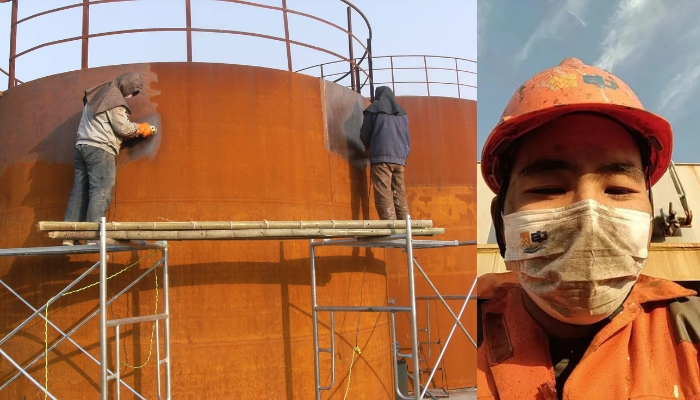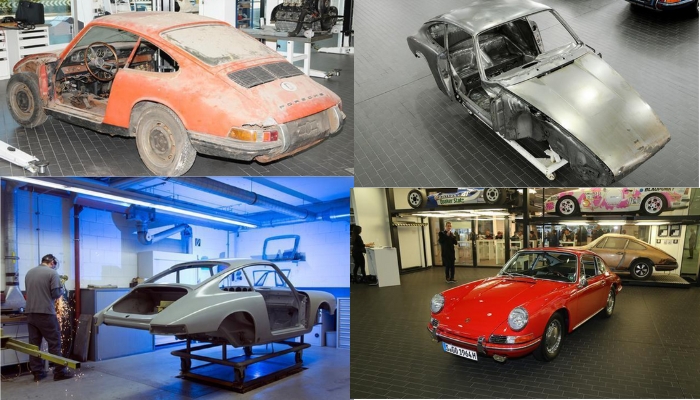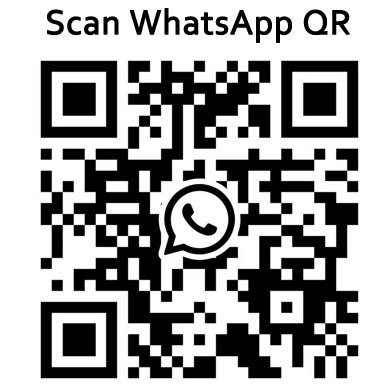Traditional methods of rust removal:
Manual Rust Removal
Manual rust removal is the most basic method, usually using hand hammers, shovels, knives, wire brushes, coarse emery cloths or sandpaper to treat metal surfaces with rust. This method is suitable for small areas or occasions where it is difficult to use mechanical equipment.
Rust Removal with electric Power Tools
Also known as semi-mechanical rust removal, using electric or wind-powered tools, such as brush wheels, angle grinders, etc., to treat the rusted surface. This method is more efficient than manual rust removal and is suitable for rust treatment of larger areas.
Spraying or blasting rust removal
With the help of oil-free compressed air or high-pressure water, this method impacts the rusted surface by spraying or ejecting abrasives (such as sand grains, steel pills, etc.) to achieve the purpose of rust removal. This method is suitable for large area and demanding rust removal work.
Chemical rust removal
Also known as pickling and rust removal, the use of inorganic dilute acid solution (such as phosphoric acid, sulfuric acid, etc.) to treat the metal surface by brushing, spraying or soaking, using chemical reactions to remove rust. This method is suitable for all kinds of metal materials, but requires attention to safety and environmental protection.
Deruster Rust Remover
Weakly acidic chemical liquids (i.e. rust removers) are used to remove rust and corrosion by brushing or dipping them into the surface of the metal to create a chemical reaction. This method is easy to operate, but the effect may be affected by the degree of rust and the material of the metal.

Traditional methods of paint removal:
Mechanical Paint Removal Method
Mechanical method mainly refers to the use of manual or mechanical scraping and sanding, high-pressure water or sandblasting, etc., relying on mechanical force to remove the old coating film. This method is usually carried out at the same time as rust removal and is applicable to various surfaces.
Immersion method
The object to be treated is immersed in a specific solution, such as lye, to soften and expand the coating film, which is then removed with a scraper. It should be noted that certain materials such as non-ferrous metals, glass, rubber, etc. are sensitive to lye and should not be used in this method.
Flame method
Use high temperature flame to make the coating film burning carbonization, to achieve the purpose of paint removal. This method is less costly, but will produce smoke to pollute the environment, harmful to human body, and may damage the surface of the object.
Removing Paint with Stripping Solution
Apply stripping solution on the old paint layer, let it soak in and then scrape off the old paint layer with a sharp paint scraper until the surface is bare. Light sanding is required afterwards to remove small residues.
Removing paint by sanding
Remove paint and smooth the surface by sanding, especially with a sander, starting with coarse sandpaper and gradually transitioning to fine sandpaper. This method is more work, but more effective.
Removing old paint with heat gun
Use a heat gun or paint burner to heat the old paint so that it curls and then scrape it off with a scraper. It is important to note that care should be taken to avoid burns and to ensure that the heat gun is placed on a surface that will not overheat.
All of the above methods can do rust and paint removal very well, but they also have many disadvantages. In the 21st century, the rise of labor price and social progress have inspired people to be more aware of environmental protection, and governments have strict requirements on environmental protection. A new green and environmentally friendly rust and paint removal method is becoming popular, Yes it is Laser rust and paint removal technology.

Laser rust and paint removal technology is based on the interaction of laser light with matter. In this process, a laser beam is focused on to a rust or paint layer on a metal surface. The energy of the laser is absorbed by the coating, resulting in rapid heating and thermal expansion of the coating. This expansion creates enough pressure to cause the coating to peel away from the metal substrate and be removed. Because the laser’s action is so short, the heat is not transferred to the metal substrate in time, so the substrate is not damaged.
Advantages of laser rust and paint removal
Efficient: Laser rust and paint removal can remove large areas of rust and paint in a very short period of time, greatly improving work efficiency.
Environmentally friendly: Compared with traditional chemical or mechanical rust removal methods, laser rust removal does not use any chemicals and therefore does not pollute the environment.
Precision: The laser beam can be precisely controlled to operate only on the area that needs to be treated, without damaging the surrounding area.
Safety: Laser rust removal does not produce dust and harmful gases, reducing health risks to operators.
Wide applicability: Laser rust removal technology is suitable for surface treatment of various metal materials and complex shapes.
Application areas of laser rust removal and paint removal
Offshore engineering: In the maintenance and repair of offshore oil steel structures, laser rust removal technology can effectively remove rust and extend the service life of the structures.
Aerospace industry: In the maintenance of aircraft and spacecraft, laser paint removal technology can remove aged paint from the surface for repainting.
Automotive paint: In the surface treatment of automotive parts, laser technology removes old paint in preparation for a new coat of paint.
Cultural Heritage Conservation: Laser cleaning technology can remove contaminants and oxides from the surface of cultural heritage without damaging the surface.
Nuclear industry: In the maintenance of nuclear facilities, laser rust removal technology can safely and effectively remove radioactive contaminants.
RFQs:
-
Does laser rust and paint removal damage the substrate?
Laser cleaning classified as CW Laser with Gaussian laser beam will have about 5μm of substrate damage.
Pulse laser with flat-top laser beam will have no damage to the substrate.
-
Are laser rust removal and painting environmentally friendly?
Yes, laser rust and paint removal does not require chemical solvents. The stripped material can be filtered through an extractor fan and purifier, making it environmentally friendly.
-
How is the effectiveness of laser rust and paint removal evaluated?
It is evaluated by a surface roughness test and the degree of damage to the substrate.
-
What are the remaining challenges of laser rust removal technology?
The core component of the laser machine, the laser source especially the pulsed laser is still expensive.
-
For what materials is laser rust and paint removal applicable?
Oxidation, rust and paint on all kinds of metal surfaces
Paint, graffiti, etc. on all kinds of non-metallic surfaces.


